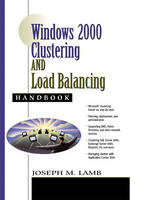
Windows 2000 Clustering and Load Balancing Handbook
Prentice Hall (Verlag)
978-0-13-065199-0 (ISBN)
- Titel ist leider vergriffen;
keine Neuauflage - Artikel merken
IT professionals attempting to build robust, high-performance clustered systems with Microsoft technology desperately need authoritative guidance written from the perspective of real, hands-on implementers. Windows 2000 Clustering and Load Balancing Handbook has what they've been searching for. Simple enough for newcomers, thorough enough for those experienced with Windows clusters, it's full of practical techniques that make it invaluable in any clustered environment. Joseph M. Lamb systematically addresses each key Windows 2000 clustering technology, including Failover Clustering, Load-Balance Clustering, Distributed Systems Clustering, and Component Load Balancing. Lamb shows how to use clustering to improve fault tolerance and performance, how to design clusters that will operate within switched Ethernet network environments; and how to integrate cluster servers with network services such as DNS, WINS, and Active Directory. The book includes real-world cluster system design examples that show how to maximize both flexibility and scalability, and provides detailed step-by-step instructions for clustering SQL Server 2000, Exchange Server 2000, Windows 2000 file/print shares, Internet Information Server and more.
JOSEPH M. LAMB has over a decade of experience managing networking and Information Systems for organizations ranging from ADP to BellSouth and The CIT Group. He now serves as the Managing Partner and Chief Executive Officer of Total Development Solutions, a consulting firm located in Atlanta, Georgia, specializing in Microsoft and Cisco products and solutions. He often lectures on Microsoft networking technologies and has taught several training classes on Microsoft clustering.
Preface.
Acknowledgments.
1. Climbing the Mountain: 24/7 Data Access.
Fault Tolerance. Performance. Scalability. Reliability. Designing Reliable Data Access. Summary.
2. What is a Cluster?
Cluster History. Clustering for Fault Tolerance. Cluster Types. Cluster Models. Windows 2000 Clustering. Summary.
3. Clustering Design Issues.
Cluster Server Planning. Hardware Requirements. Software Requirements. Placement Considerations. Network Services. Design Samples. Summary.
4. Building a Failover Cluster.
Resource Configuration. Hardware Configuration. Operating System Install. Network Configuration. -Configuring the Shared Disk Array. Clustering Software Install. Testing the Installation. Managing the Failover Cluster.
5. Building a Load-Balanced Cluster.
How Does It Work? Preplanning. Operating System Install. Configuring NLB. -Configuring Internet Information Server. Testing the Installation. -Managing a Network Load-Balanced Cluster. Summary.
6. Microsoft Application Center 2000.
Product Overview. Product Features. Installing AC 2000. -Component Load Balancing: Three-Tiered Clusters. Managing AC 2000.
7. Clustering Microsoft SQL Server.
Overview of SQL Clustering. Designing an SQL Cluster. -Installing SQL Server 2000 on a Cluster. -Managing an SQL Server Cluster. Summary.
8. Clustering Exchange Server 2000.
-Overview of Exchange Server Clustering. -Designing an Exchange Server 2000 Cluster. -Installing Exchange Server 2000. -Managing Exchange Server 2000.
9. Clustering Internet Information Server.
IIS Overview. Clustering the WWW Service. Clustering the FTP Service. Clustering the SMTP Service. Summary.
10. Clustering File and Print Services.
Introduction. Clustering File Shares. Clustering DFS. Clustering Print Shares. Summary.
Index.
| Erscheint lt. Verlag | 26.11.2001 |
|---|---|
| Verlagsort | Upper Saddle River |
| Sprache | englisch |
| Maße | 234 x 177 mm |
| Gewicht | 680 g |
| Themenwelt | Informatik ► Betriebssysteme / Server ► Windows |
| Informatik ► Betriebssysteme / Server ► Windows Server | |
| ISBN-10 | 0-13-065199-0 / 0130651990 |
| ISBN-13 | 978-0-13-065199-0 / 9780130651990 |
| Zustand | Neuware |
| Haben Sie eine Frage zum Produkt? |
aus dem Bereich


